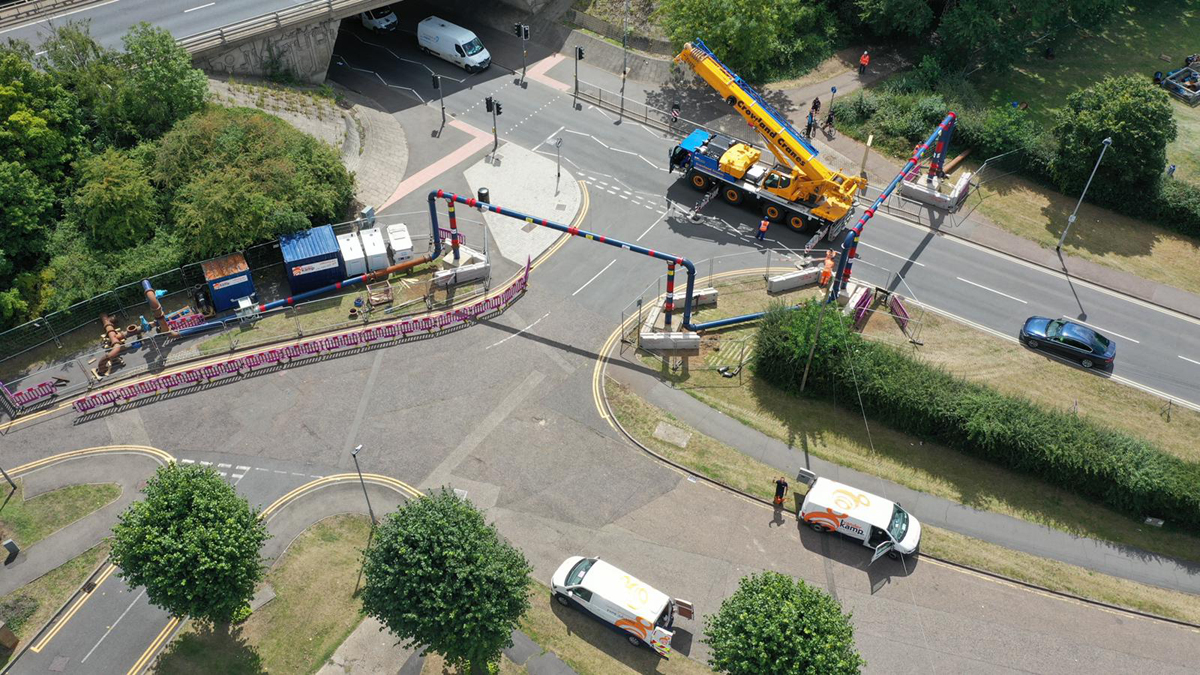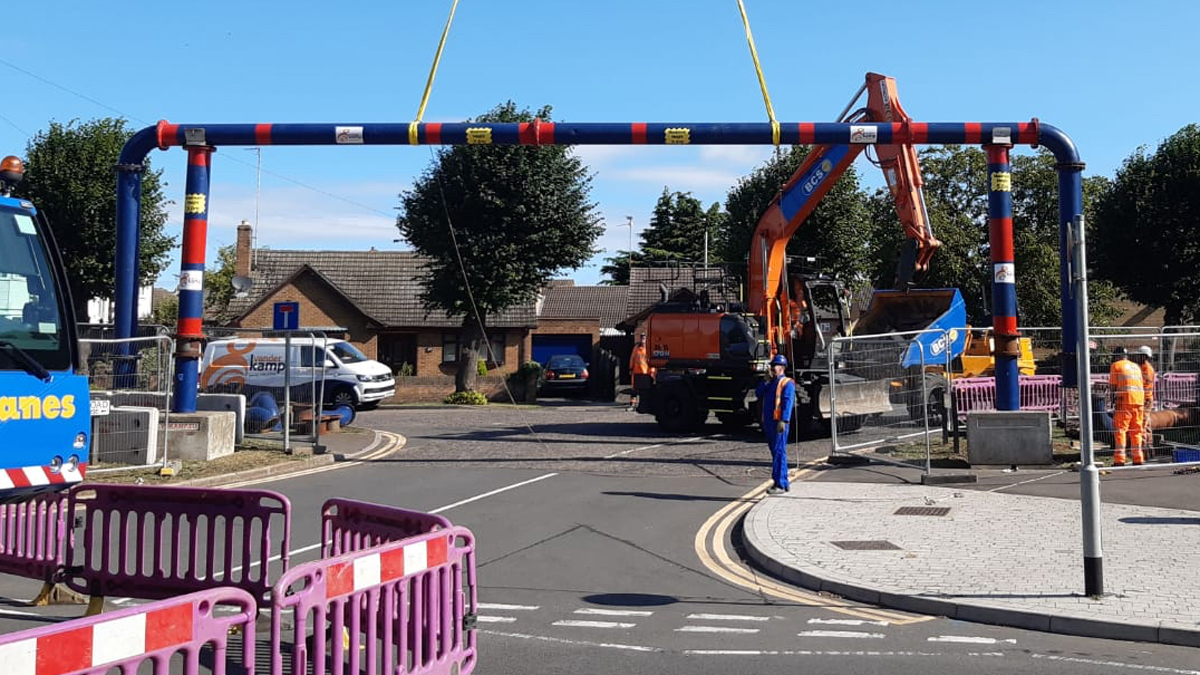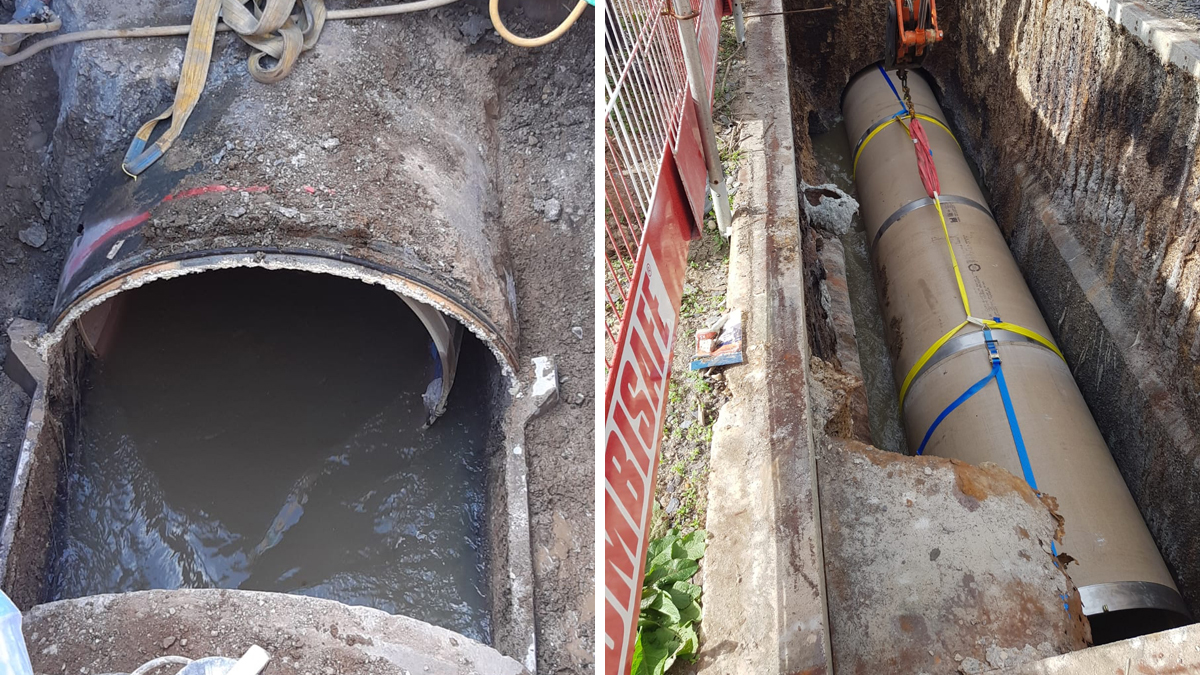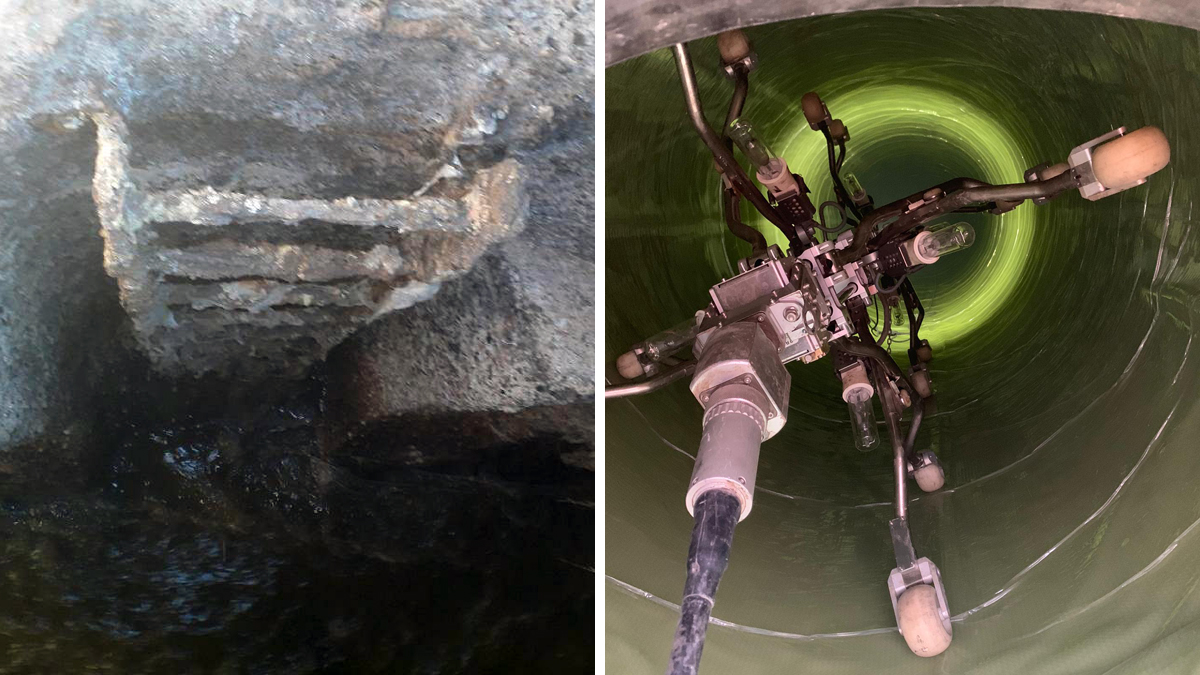Potters Way Sewer Rehabilitation (2023)

Aerial view of Potters Way works - Courtesy of @one Alliance
Potters Way, located in the Fengate area of Peterborough, is a recent housing development next to the A1139. The development was built on the grounds of the former Fengate Water Recycling Centre (WRC) which closed in 1988 following the construction of the Flag Fen WRC. In early December 2018, Anglian Water became aware of the collapse of a section of 1500mm diameter concrete sewer pipe in Potters Way when a small hole was found after a customer used a ride-on lawn mower over the area. Temporary repair works were undertaken by the Integrated Operational Solutions (IOS) Alliance – a partnership between Anglian Water, Kier, Barhale and Morrison Utility Services – while a permanent fix could be designed and implemented.
Background
By the end of December, the IOS Alliance had installed a temporary repair using a vacuum excavator to safely clear the collapsed pipe before using half-pipe and canvas to seal the collapse. The area was also fenced off to prevent pedestrian access and ensure site safety.
During this period, Anglian Water received several complaints from customers over the odour created by the collapse. Following meetings with the residents, Anglian Water’s Water Recycling Networks (WRN) team further sealed the excavation and installed carbon filters to the air valves. At the same time, the team repaired holes found in the rising main pipework at the nearby tower.
The site was then handed over to the Anglian Water @one Alliance to implement their repair solution with @one partner company Barhale engaged as principal contractor.

Installation of the overhead diversion – Courtesy of @one Alliance
Finding a solution
One of the challenges presented in finding a solution for this project was the high flow rate of the pipework, with modelling of Potters Way showing flow rates of 3,700 litres per second in the event of a 1 in 30-year storm. Downstream of Potters Way, this rises to 4,000 litres per second.
To make the matter even more complicated, the pipe featured several significant bends along the affected route that increased the difficulty of finding an adequate solution.
An extensive survey of 2.8km of sewer identified 1.79km of concrete sewer pipework ranging in diameter from 1050mm to 1950mm had a condition grade of either 4 or 5. All these pipes were identified as having been subjected to a hydrogen sulphide (H2S) attack which had caused the significant deterioration. The @one Alliance set out to repair an area of the network by covering a key 500m of pipework which serves the majority of Peterborough.
Potters Way Sewer Rehabilitation: Supply chain
- Project delivery: Anglian Water @one Alliance
- Temporary repairs: Integrated Operational Solutions (IOS) Alliance
- Principal contractor: Barhale
- Over pumping: Vanderkamp UK
- GRP pipe lining: Amiblu Norway AS
- Lining & manhole repair: OnSite Central Ltd
- Specialist CCTV Survey: Bright Innovations Group
- Foam concrete: GS Foam Concrete
- Diamond cutting: SCS Ltd
- Cover slabs: FP McCann Ltd
- Temporary works/shoring: Groundforce
Pipe rehabilitation
The @one Alliance solutions team opted for a multi-stage solution due to the complex nature of the pipework and the compact area the teams would be working in.
In order to repair the sewer, it was decided that a mix of CIPP (cured in place pipe) and GRP (glass reinforced plastic) lining would be used. The majority of the rehabilitation was completed using CIPP lining which allows the lining to be inserted into the shell of the existing, damaged pipework where it is then pressurised and cured in place with ultraviolet (UV) lights.
The CIPP relining was split into eight sections covering approximately 360m of the repaired pipeline. At 1375mm in diameter, this installation was the largest diameter CIPP liner that the @one Alliance had ever installed. Six of the eight lengths of CIPP were installed under the A1139.
Over pumping
In order to fit the CIPP liners, the team utilised an over pumping set up capable of 250 litres per second (l/s). By using bungs at split manholes on the nearby Bourges Boulevard, the team could redirect the flow and use the pumping set up to divert the rest of the flow.
The over pumping solution was provided by Vanderkamp UK who had remote monitoring capabilities from the Netherlands and provided the site teams with a mobile app allowing them to see real time data giving them advanced warning of increased flows which would require the removal of the bungs. Without this passive flow management, the over pumping setup would have needed to be able to cope with an excess of 2,000 l/s.
The set up was made up of two pipe bridges 350mm in diameter and 5.5m high to allow clearance for high-sided vehicles.
GRP lining
Alongside the CIPP lining, the team also used GRP lining on a 48m section of 1500mm diameter sewer executing the rehabilitation in live flow conditions of approximately 850 litres per second; the first time the @one Alliance had installed GRP lining in live flow conditions.

(left) Live flow conditions and (right) inserting a new section of Amiblu Norway AS GRP pipe – Courtesy of @one Alliance
Operating in live flow removed the necessity to install an additional over pumping solution that would have dealt with 95% of Peterborough’s sewage as it combined into one flow towards Flag Fen WRC.
In order to commence the GRP lining, the crown of the pipe was removed on a bend and concrete platforms were constructed on either side ensuring a safe working area. A pipe pusher attachment was then used to insert segments upstream and downstream from the bend location. Finally, a prefabricated GRP bend section was installed and connected to straight sections.
To safely cut the existing mains the team needed to excavate an area of 6m x 4.5m with a depth of 3.5m. While having to excavate in an urban area is an option the team would have liked to have avoided, the next best solution to the live flow repair would have included installing a temporary pumping station that would have taken up all of Potters Way’s parking and grass area requiring 10 pumps and a 10m x 7m x 7m temporary wet well to complete the required repair. This would have been a major inconvenience for residents and would have seen an increase in the overall cost of the project of 200%.
Amiblu relining pipes to protect sewer networks from H2S attacks – Courtesy of Amiblu Norway AS
Manhole rehabilitation
As part of the pre-work checks, it was identified that eleven manholes along the section of pipework required rehabilitation of various levels with the most severely affected requiring structural repair as a result of H2S attacks. Core samples were taken from one manhole which identified that in some places, more than 150mm of concrete had been lost to H2S attacks with no rebar remaining in any of the samples.
To repair the manhole, the team used a concrete spray to bring the walls back to their original 250mm thickness, once this had cured a primary and finishing layer were added to ensure full protection against H2S attacks in the future.
A new cover slab was also installed after the original was removed to provide access to the manhole, made of precast concrete the slab was also treated for H2S protection.

(left) H2S attack on a manhole and (right) inside a relined section of pipe – Courtesy of @one Alliance
Challenges
Weather provided a significant challenge for the implementation of the solution as the site experienced an unusually heavy rainfall. Flow rate analysis for Flag Fen WRC shows that in the previous five years the average rainfall for the area fell between 35mm and 60mm. August 2020 saw average rainfall of 137mm.
Because of the heavy rainfall several weather warnings were issued placing all CIPP lining activities on hold. The impact of the weather was so severe the flow of water increased from its usual 850l/s to 4,000 l/s in just 10 minutes. In order to reduce the risk of flooding outside the Magistrates Court the bungs were deflated, and the flow reverted.
Due to the innovative combination of flow diversion and overpumping used in the CIPP lining the impact of the delay was significantly reduced compared to if the team had used the temporary pumping station solution.
Rising mains issues
During the repair of the sewer the @one Alliance became aware of complaints from the residents regarding the twin rising mains on Potters Way which used to feed into the old Peterborough STW and was diverted into the new gravity sewer discharging into Flag Fen WRC.
The primary complaint from customers was the odour produced by the rising mains. The old Peterborough STW was sold for development and the rising mains tower was marked for removal. In early 2022 the @one Alliance returned to Potters Way removing the rising mains and installing a pumping station kiosk removing the odour and significantly reducing the visible profile in the area.
Result
Anglian Water invested £2.8m into the Potters Way project which will now allow customers across Peterborough to continue to use their taps and flush their toilets without second thought.
The relining of the sewer network has ensured the network in the Potters Way area is now protected from H2S attacks for the next 50 years. Colin Handley, Construction Manager said:
“There was fantastic team collaboration between our Tier 2 Supply Chain Partners, the Principal Contractor (Barhale) and the @one Alliance, making it one team delivering the programme. The teams worked tirelessly to monitor the smells and reduce odours, whilst working in open excavations. They purchased additional fans and diverted rising mains to lower H2S and to allow the teams to work safely.”







